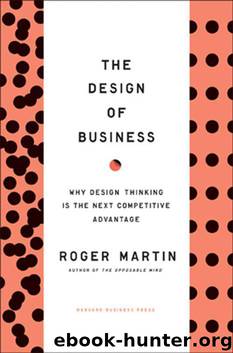Design of Business by Roger L. Martin

Author:Roger L. Martin [Martin, Roger L.]
Language: eng
Format: epub
ISBN: 9781422177808
Publisher: Perseus Books Group
Published: 0101-01-01T00:00:00+00:00
Designing New Processes
In addition to equipping his managers with more skills and expertise in design thinking, Lafley worked to change organizational norms to support design thinking. He modeled that thinking in his own behavior, doing in-depth at-home visits with consumers wherever he traveled. He even chatted (through a translator) with rural Chinese women washing clothes in a river. After all, they use detergent too.
He changed key processes, including strategy review. The tradition at P&G was that each category president came to the annual review with a thick deck of slides that culminated in a single right answer for the coming year, including all the inductive and deductive proof needed to gain the approval of the CEO and senior management. Additional slides were prepared to address any objections top management could conceivably raise.
Lafley recognized that this process was a recipe for producing reliability, not validity. The category presidents wanted their strategies to be airtight, so risky creative leaps were out of the question. Lafley saw he had to stop the drive for reliability before it gathered momentum, so he devised a new process. Presidents would submit their slide decks two weeks before the strategy review. Lafley would read the materials and issue a short list of questions that he wanted to discuss at the meeting. He emphasized that he wanted a discussion, not a presentation. Presidents were allowed to bring only three more pieces of paper—charts, graphs, notes—to the review. Only by more or less forcing category managers to toss around ideas with senior management, he reasoned, could they become comfortable with the logical leaps of mind needed to generate new ideas.
At first the presidents and their teams bridled at Lafley’s new process. Actual dialogue at the senior levels of P&G was exceedingly rare before Lafley became CEO. Rather than engaging in dialogue, executives devoted their time and energy to bulletproofing arguments and then advocating and defending them. Dialogue was different, foreign—and unnerving. Only after two or three cycles did it dawn on the presidents how invigorating and mind opening it was to engage in dialogue about what could be rather than what was. It was also great for their businesses. Freed from the demand to come up with the single right answer and prove it, they started to work out bigger bets with the corporate team.
To elevate design thinking in the corporate hierarchy of values, Lafley made the solving of wicked problems a high-status, glamorous assignment. (For a short primer, see “Wicked Problems.”) For instance, the executives who turned around the baby-care business, which had been in secular decline for almost a decade, were at least as highly rewarded as those running bigger or more stable businesses. He also set up explicitly project-based work with managers, making clear that their work was time bound and that they would go on to another project or assignment when they had completed their current project.
In addition to building skills and changing organizational processes and norms, Lafley made dramatic interventions at each stage of
Download
This site does not store any files on its server. We only index and link to content provided by other sites. Please contact the content providers to delete copyright contents if any and email us, we'll remove relevant links or contents immediately.
Bad Blood by John Carreyrou(6517)
Rich Dad Poor Dad by Robert T. Kiyosaki(6354)
Principles: Life and Work by Ray Dalio(6170)
Playing to Win_ How Strategy Really Works by A.G. Lafley & Roger L. Martin(5856)
Management Strategies for the Cloud Revolution: How Cloud Computing Is Transforming Business and Why You Can't Afford to Be Left Behind by Charles Babcock(4510)
The Confidence Code by Katty Kay(4172)
Thinking in Bets by Annie Duke(4139)
American Kingpin by Nick Bilton(3736)
Delivering Happiness by Tony Hsieh(3353)
Project Animal Farm: An Accidental Journey into the Secret World of Farming and the Truth About Our Food by Sonia Faruqi(3163)
The Power of Habit by Charles Duhigg(3043)
Brotopia by Emily Chang(2989)
The Tyranny of Metrics by Jerry Z. Muller(2980)
Mastering Bitcoin: Programming the Open Blockchain by Andreas M. Antonopoulos(2964)
The Marketing Plan Handbook: Develop Big-Picture Marketing Plans for Pennies on the Dollar by Robert W. Bly(2950)
I Live in the Future & Here's How It Works by Nick Bilton(2919)
The Content Trap by Bharat Anand(2850)
Applied Empathy by Michael Ventura(2827)
Building a StoryBrand by Donald Miller(2825)
